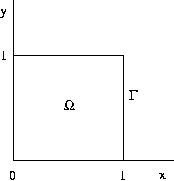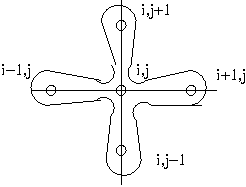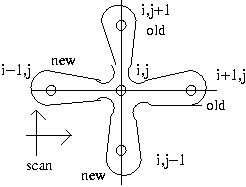| (1) |
Based on notes by Guillermo Marshall, University of Buenos Aires
We are looking for solutions of the partial differential equations encountered in Mathematical Physics. The object of this section is to model physical systems and predict their behavior.
We will use the Finite Difference approach in solving these equations. In this approach the solution of the equations is sought on an equally space lattice in both space and time.
The Taylor series expansion of a function near x0 reads
| (1) |
| (2) |
| (3) |
| (4) |
A more accurate form follows by combining the
Taylor series expansions with the function evaluated at x0:
| (5) |
| (6) |
The Laplace equation (in 2-D)
| (7) |
| (8) |
These equations are said to be of Elliptic type.
No time dependence is involved here. A time independent
solution for u(x,y) is sought after within a domain
![]() .
In 2-D the domain could be a simple rectangle,
.
In 2-D the domain could be a simple rectangle,
![]() and
and
![]() ,
or could be of arbitrary
shape.
,
or could be of arbitrary
shape.

The solution, or its derivative, is specified at the
boundary of the domain, ![]() .
The possibilities are:
.
The possibilities are:
| u(x,y) = f(x,y), | (9) |
| (10) |
In a finite difference solution of the partial differential equation,
an equally spaced grid is set ( hx = hy for simplicity ) to cover
the domain. The number of grid points is
![]() .
The grid coordinates are
xi = hx i and
yj = hy j.
The unknown field and the source are
written on this grid.
.
The grid coordinates are
xi = hx i and
yj = hy j.
The unknown field and the source are
written on this grid.
| u(xi,yj) = ui,j | (11) |
| S(xi,yj) = Si,j | (12) |
Using the formula for the partial derivative leads to the following form
for the partial differential equation:
| (13) |
The equation above form a linear system of
equations which in principal could be solved
for ui,j for all points in the interior of the domain ![]() .
This is a difficult set of equations to solve because of various
reasons: first, there is no obvious ``pattern'' to the left and right
hand sides, specially since the boundary values of the the field must
be transferred to the known right hand side. Second, the number of
unknown can be very large, of the order
.
This is a difficult set of equations to solve because of various
reasons: first, there is no obvious ``pattern'' to the left and right
hand sides, specially since the boundary values of the the field must
be transferred to the known right hand side. Second, the number of
unknown can be very large, of the order
![]() in 2-D.
A 3-D problem using a
in 2-D.
A 3-D problem using a
![]() lattice
would involve 109 equations!
lattice
would involve 109 equations!
A solution of the finite difference equations
can be obtained iteratively. An initial value for the
field ui,j is guessed for all interior points
in the domain. The value of
the field at the grid point i and j is solved
assuming that the field at the other grid locations is known.
| (14) |
The Jacobi method uses a new ``array'' to store the new value of the field ui,j at the interior grid points.

The Gauss-Siedel method consists in replacing the new value of the
field within the same ``array''. This corresponds to the
following form:
| (15) |

The iterations are repeated until convergence. This is checked by
calculating the largest change between the old and new field
at all interior points in the domain at each iteration
| (16) |
This numerical solution is unconditionally stable, i.e., it will converge to a solution. The accuracy of the solution is a separate issue; it depends on the adequacy of the numerical grid to describe the regions of high curvature of the field and on the ability of the numerical grid to cover the domain.
The Gauss-Siedel method converges faster than the Jacobi method. Yet
it is a notoriously slow method, often requiring very large number
of iterations to achieve convergence. A better rate of convergence
is achieved by the Succesive Over Relaxation
(SOR) method. In this approach, the old and new fields are
mixed via a parameter ![]() .
.
| (17) |
| (18) |
![]() may change as a function of iteration number.
It is taken to be small for few iterations, increased to
a value close to 1 for many iterations, and eventually taken larger
than 1 to ``accelerate'' convergence in the latter stages of the iteration
process. The choice of the best value for
may change as a function of iteration number.
It is taken to be small for few iterations, increased to
a value close to 1 for many iterations, and eventually taken larger
than 1 to ``accelerate'' convergence in the latter stages of the iteration
process. The choice of the best value for ![]() is discussed
in ``Numerical Recipes'' in the section on SOR.
is discussed
in ``Numerical Recipes'' in the section on SOR.
This document was generated using the LaTeX2HTML translator Version 98.1p1 release (March 2nd, 1998)
Copyright © 1993, 1994, 1995, 1996, 1997, Nikos Drakos, Computer Based Learning Unit, University of Leeds.
The command line arguments were:
latex2html Poisson.tex.
The translation was initiated by Michel Vallieres on 2001-05-11